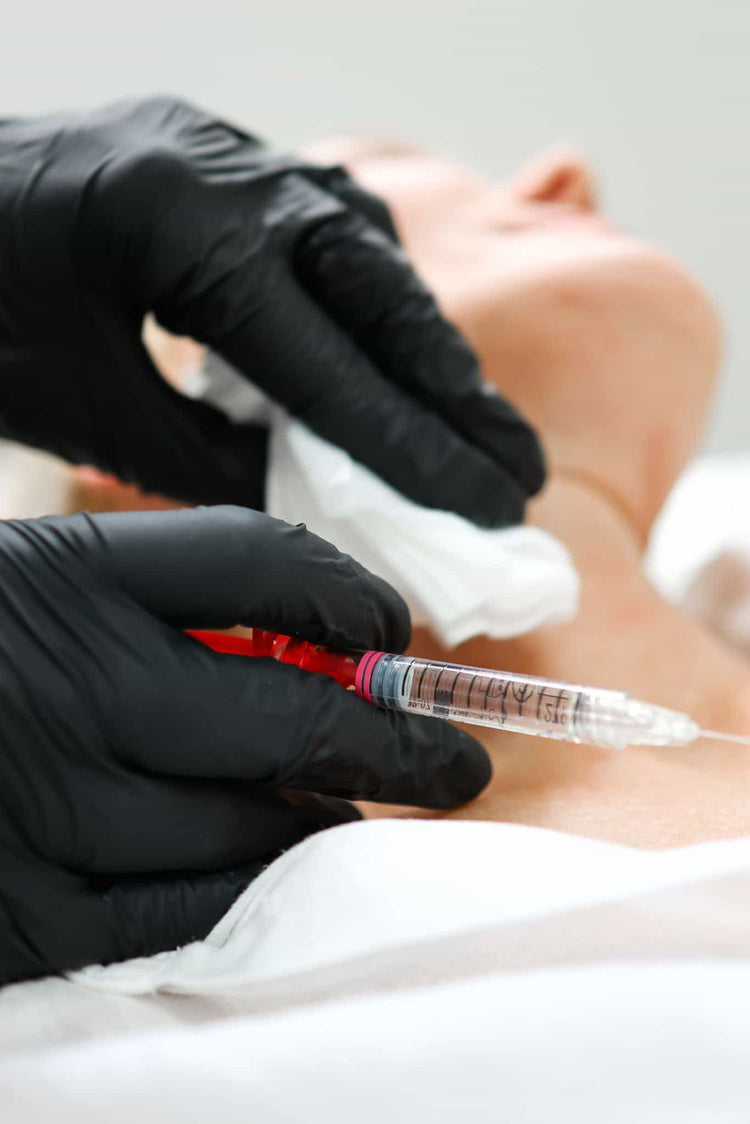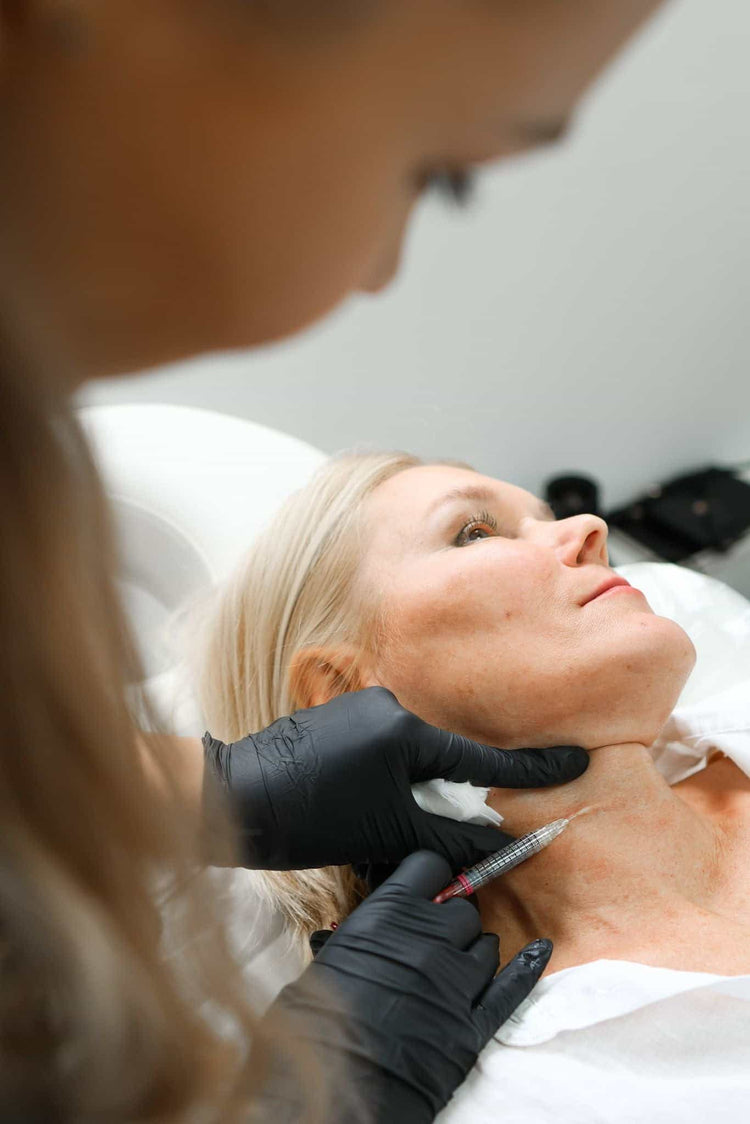Benefits of Hyaluronic Acid for Neckline Fillers
Hyaluronic acid has become increasingly popular as a dermal filler, particularly for addressing concerns about the neckline. Its unique properties make it an ideal choice for smoothing out wrinkles and restoring volume to this often-neglected area.
Volume Restoration
Hyaluronic acid is a naturally occurring substance in the body that attracts and retains moisture. This hydrating ability makes it an excellent ingredient for cosmetic fillers, as it can plump up the skin and reduce the appearance of fine lines and wrinkles.
In the delicate area of the neckline, hyaluronic acid fillers can be particularly effective in restoring volume lost due to aging. As we age, our natural collagen production declines, leading to a loss of firmness and definition in the neck region. Hyaluronic acid fillers can help replenish this lost volume, creating a smoother, more youthful appearance.
Another benefit of hyaluronic acid is its temporary nature. Since it is absorbed by the body over time, results from treatments using hyaluronic acid fillers typically last for several months to a year. This allows individuals to enjoy an enhanced appearance without committing to permanent changes.
Hydration and Skin Texture Improvement
The natural hydrating properties of hyaluronic acid make it particularly well-suited for addressing the specific concerns of the neckline. As we age, the skin on our necks tends to lose moisture, leading to dryness and the appearance of fine lines and wrinkles. Hyaluronic acid’s ability to attract and retain water helps plump up the skin, reducing the visibility of these imperfections and restoring a smoother, more hydrated look.
Moreover, hyaluronic acid fillers can be strategically injected into the neck to add volume and restore definition. This can help counteract the effects of gravity and aging, which often lead to sagging and a loss of firmness in the neck area. By plumping up the skin and adding structure, hyaluronic acid fillers can create a more contoured and youthful neckline.
Natural-Looking Results
Hyaluronic acid’s natural presence in the body makes it a perfect candidate for neckline fillers. It acts like a sponge, attracting and holding onto moisture, which is crucial for maintaining skin plumpness and elasticity.
In the delicate area of the neckline, where signs of aging often become prominent, hyaluronic acid can effectively combat wrinkles and restore volume. As we age, collagen production naturally declines, leading to sagging and a loss of definition in the neck region. Hyaluronic acid fillers counteract this by plumping up the skin, smoothing out lines, and restoring a more youthful appearance.
The temporary nature of hyaluronic acid fillers is another benefit. Since they are gradually absorbed by the body, results typically last for several months to a year. This allows individuals to enjoy an enhanced appearance without making a permanent commitment.
Suitability for Different Skin Types
Hyaluronic acid has emerged as a popular choice for dermal fillers due to its ability to hydrate and plump the skin.
Sensitivity Considerations
Hyaluronic acid is well-suited for various skin types, as it is naturally found in the body and interacts gently with skin cells. However, individuals with sensitive skin should exercise caution and consult a qualified practitioner before undergoing any filler treatment. A patch test may be recommended to assess potential reactions.
Sensitivity considerations are important when using hyaluronic acid fillers. While generally well-tolerated, some individuals may experience mild side effects such as redness, swelling, or bruising at the injection site. These typically subside within a few days. It is crucial to select a skilled and experienced practitioner who uses high-quality products and sterile techniques to minimize the risk of adverse reactions.
Combination and Oily Skin
For combination and oily skin, hyaluronic acid can be particularly beneficial.
While it attracts and retains moisture, hyaluronic acid does not clog pores or contribute to excess oil production.
It helps balance the skin’s hydration levels by providing moisture to drier areas while not exacerbating oiliness in oilier zones.
Dry or Mature Skin
Hyaluronic acid is suitable for a range of skin types, including dry and mature skin. Its ability to attract and hold moisture makes it particularly beneficial for addressing the dryness and wrinkles often associated with aging skin.
For dry skin, hyaluronic acid can help replenish lost hydration, improving skin texture and reducing the appearance of fine lines. In mature skin, it can plump up the skin, minimizing the look of wrinkles and restoring a more youthful appearance.
Treatment Procedure and Recovery
Treatment for neck line concerns typically involves injecting hyaluronic acid fillers strategically beneath the skin. This plumps the area, smoothing wrinkles and restoring lost volume. The results are generally temporary, lasting several months to a year, allowing for adjustments over time.
Consultation Process
The treatment process for neckline fillers typically begins with a consultation. During this appointment, a qualified practitioner will assess your individual needs and concerns, discuss your desired outcome, and explain the procedure in detail. They will examine your neck area, considering factors like skin type, existing wrinkles, and muscle structure to determine the best approach.
Before the treatment, a topical anesthetic may be applied to minimize any discomfort. The hyaluronic acid filler is then injected into specific points along the neckline using a fine needle. This process is generally quick and relatively painless, although some individuals may experience mild pressure or stinging sensations during injection. After the procedure, you may have some redness or swelling at the injection sites, but these typically subside within a few days.
Recovery from neckline fillers is generally minimal. Most patients can return to their normal activities immediately after the treatment. Avoid strenuous activity and direct sun exposure for a few days following the procedure. It’s important to follow your practitioner’s post-treatment instructions carefully to ensure optimal results and minimize any potential risks or side effects.

Injection Technique
Treatment for neck line concerns typically involves injecting hyaluronic acid fillers strategically beneath the skin. This plumps the area, smoothing wrinkles and restoring lost volume. The results are generally temporary, lasting several months to a year, allowing for adjustments over time.
The treatment process for neckline fillers typically begins with a consultation. During this appointment, a qualified practitioner will assess your individual needs and concerns, discuss your desired outcome, and explain the procedure in detail. They will examine your neck area, considering factors like skin type, existing wrinkles, and muscle structure to determine the best approach.
Before the treatment, a topical anesthetic may be applied to minimize any discomfort. The hyaluronic acid filler is then injected into specific points along the neckline using a fine needle. This process is generally quick and relatively painless, although some individuals may experience mild pressure or stinging sensations during injection. After the procedure, you may have some redness or swelling at the injection sites, but these typically subside within a few days.
Recovery from neckline fillers is generally minimal. Most patients can return to their normal activities immediately after the treatment. Avoid strenuous activity and direct sun exposure for a few days following the procedure. It’s important to follow your practitioner’s post-treatment instructions carefully to ensure optimal results and minimize any potential risks or side effects.
Aftercare Instructions
Hyaluronic acid is naturally found in the body and is responsible for maintaining skin hydration and plumpness. When injected as a filler, it attracts water molecules, increasing volume and smoothing out wrinkles.
Treatment typically involves injecting hyaluronic acid into specific points along the neckline using a fine needle. A topical anesthetic may be applied to minimize discomfort. Recovery is generally quick with minimal downtime.
Aftercare instructions typically include avoiding strenuous activity and direct sun exposure for a few days following treatment. It’s important to follow your practitioner’s specific post-treatment instructions for optimal results and to minimize the risk of side effects. Results typically last several months to a year, allowing for adjustments over time.
Safety and Longevity of Results
Hyaluronic acid has emerged as a popular choice for dermal fillers due to its ability to hydrate and plump the skin. Its natural presence in the body makes it a perfect candidate for neckline fillers. It acts like a sponge, attracting and holding onto moisture, which is crucial for maintaining skin plumpness and elasticity.
In the delicate area of the neckline, where signs of aging often become prominent, hyaluronic acid can effectively combat wrinkles and restore volume. As we age, collagen production naturally declines, leading to sagging and a loss of definition in the neck region. Hyaluronic acid fillers counteract this by plumping up the skin, smoothing out lines, and restoring a more youthful appearance.
The temporary nature of hyaluronic acid fillers is another benefit. Since they are gradually absorbed by the body, results typically last for several months to a year. This allows individuals to enjoy an enhanced appearance without making a permanent commitment.
FDA Approval and Quality Standards
When considering dermal fillers for the neckline, safety and longevity of results are paramount. Hyaluronic acid, a popular choice for this area, is generally well-tolerated due to its natural presence in the body. Reputable practitioners use high-quality hyaluronic acid fillers that meet stringent quality standards and undergo rigorous testing.
FDA approval is not required for all dermal fillers in certain countries, including some variations of hyaluronic acid. However, reputable manufacturers prioritize obtaining necessary approvals and certifications to ensure product safety and efficacy. It’s essential to inquire about the specific filler being used and its regulatory status with your practitioner.
The longevity of hyaluronic acid fillers typically ranges from several months to a year, depending on factors such as individual metabolism, lifestyle, and the specific type of filler used. Regular touch-up appointments can help maintain desired results over time.
Expected Duration of Effects
Hyaluronic acid is generally considered safe for use in dermal fillers due to its natural presence in the body.
Reputable practitioners prioritize safety by using high-quality hyaluronic acid fillers that have undergone rigorous testing and meet industry standards.
The longevity of results from hyaluronic acid fillers typically ranges from several months to a year, depending on factors such as individual metabolism, lifestyle, and the specific type of filler used. Regular touch-up appointments can help maintain desired results over time.

Potential Side Effects and Complications
When considering dermal fillers for the neckline, safety and longevity of results are paramount. Hyaluronic acid, a popular choice for this area, is generally well-tolerated due to its natural presence in the body. Reputable practitioners use high-quality hyaluronic acid fillers that meet stringent quality standards and undergo rigorous testing.
FDA approval is not required for all dermal fillers in certain countries, including some variations of hyaluronic acid. However, reputable manufacturers prioritize obtaining necessary approvals and certifications to ensure product safety and efficacy. It’s essential to inquire about the specific filler being used and its regulatory status with your practitioner.
The longevity of hyaluronic acid fillers typically ranges from several months to a year, depending on factors such as individual metabolism, lifestyle, and the specific type of filler used. Regular touch-up appointments can help maintain desired results over time.
Potential side effects associated with hyaluronic acid fillers are generally mild and temporary.
- Redness
- Swelling
- Bruising
- Tenderness
These side effects typically resolve within a few days. In rare cases, more serious complications such as infection or allergic reactions can occur. It’s crucial to consult with a qualified and experienced practitioner who uses sterile techniques and high-quality products to minimize the risk of complications.
- Filler For Volume Loss In Walton-on-Thames, Surrey - September 28, 2025
- Downturned Smile Treatment Near Shirley, Surrey - September 26, 2025
- How To Tell If Your Kratom Powder Is Contaminated - September 25, 2025
